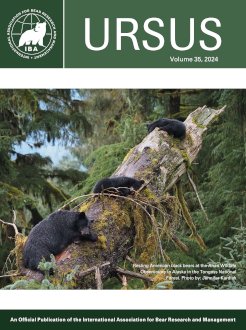Assessing the seasonal changes in body condition (BC) of animals is important for understanding their reproduction and survival, as well as human–animal interaction. Visual or photographic assessment of BC has, however, been limited to species in open habitats or to specific times and locations. To noninvasively assess the seasonal changes in the entire local population of brown bears (Ursus arctos) inhabiting the forest habitat in eastern Hokkaido, Japan, we evaluated their BC using camera-trapping during 2015–2017. We assigned a 5-point BC score (BCS) for each individual based on the images, and examined seasonal changes in BCS by sex–age classes. Out of the 1,714 events in which brown bears were recorded, sex–age classes including adult males, subadults, females with offspring, and solitary adult females, could be determined in 887 events. Overall, BCS tended to decrease from spring to summer, with the lowest value in July, and tended to increase toward autumn, with the highest value in November. The BCS of adult male bears showed the highest seasonal variation, whereas that of subadults showed the least variation. Adult females, both solitary and those with offspring, showed intermediate seasonal variation in BCS compared with adult males and subadults. These seasonal changes were considered to be a general pattern and point to the amount of accumulated body fat. Adult males have a larger home range and, because of their social dominance, can exploit higher quality resources than can be exploited by other sex–age classes, which results in them being able to accumulate relatively more fat during hyperphagia. Females with offspring tended to have a lesser increase in BCS after August and lower BCS in autumn than did solitary adults. We were able to demonstrate the possibility of evaluating the BC of individuals and their seasonal changes by examining BCS based on the videos taken by camera traps.
How to translate text using browser tools
8 April 2024
Using camera traps to assess body condition of brown bears in Hokkaido
Shuhei Kanazawa,
Kento Nomura,
Koya Tani,
Yuki Ishibashi,
Moemi Tsukano,
Kurumi Kawamura,
Hisaaki Toyoshima,
Yoshikazu Sato
ACCESS THE FULL ARTICLE

Ursus
Vol. 2024 • No. 35e7
April 2024
Vol. 2024 • No. 35e7
April 2024
Body condition score
camera traps
forest habitat
hibernation
Hokkaido
hyperphagia
noninvasive assessment




